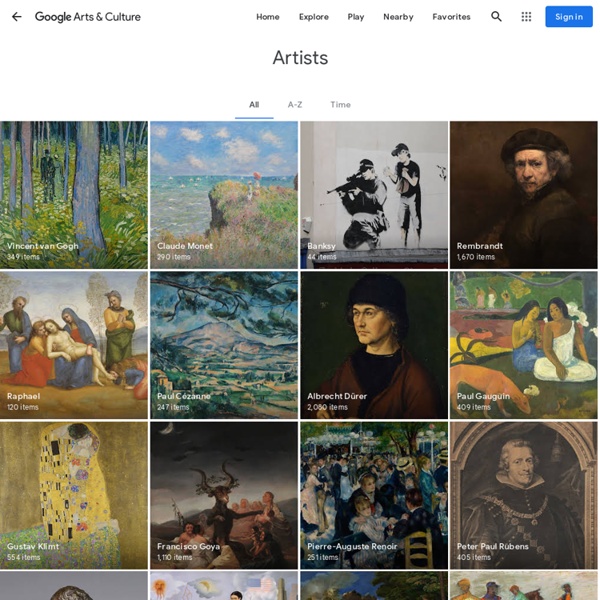



https://artsandculture.google.com/category/artist
Related: HISTOIRE DES ARTS • RECURSOS TIC • Interesantes 19/20/21Fondation Bemberg: L'Art en s'amusant Le portrait L'énigme Tête de jeune paysan - Paul GAUGUIN (1848-1903) – Fin XIXe siècle – Huile sur toile Nearpod: herramienta digital para gamificación y trabajo colaborativo Nearpod es una herramienta efectiva de gamificación y aprendizaje colaborativo especialmente para alumnos de nivel primaria y secundaria. Se trata de una aplicación para crear ambientes de aprendizaje donde el alumno se sienta motivado a participar en la construcción de un nuevo conocimiento. Nearpod es una aplicación que permite gestionar diferentes presentaciones en función de las diferentes temáticas abordadas en un curso. Entre los beneficios de esta aplicación podemos mencionar que mejora la atención de los estudiantes, aumenta la retención y su uso es sencillo de aprender y ejecutar. Además, permite al docente la innovación en la planeación de secuencias didácticas.
Public art At the turn of the millennium, public art was an established global art genre with its own professional and critical discourse, as well as constituencies of interest and patronage independent of mainstream contemporary art. Art criticism has been prodigious regarding public art’s role in the ‘beautification’ of otherwise neglected social space or in influencing urban development. Diversity and differentiation are increasingly the hallmarks of public art worldwide, emerging from city branding strategies and destination marketing as well as from artist activism and international art events and festivals. The first decade of the 21st century demonstrated the vast opportunity for creative and critical ‘engagement’, activism, social dialogue, and cultural co-creation and collective participation.
Italian Renaissance The Italian Renaissance was a period of Italian history that began in the 14th century and lasted until the 17th century. It peaked during the 15th and 16th centuries, spreading across Europe and marking the transition from the Middle Ages to Modernity. The French word renaissance means "rebirth" and defines the period as one of cultural revival and renewed interest in classical antiquity after the centuries labeled the Dark Ages by Renaissance humanists. The Renaissance author Giorgio Vasari used the term "Rebirth" in his Lives of the Most Excellent Painters, Sculptors, and Architects but the concept became widespread only in the 19th century, after the works of scholars such as Jules Michelet and Jacob Burckhardt.The Renaissance began in Tuscany, and was centred in the city of Florence. Florence, one of the several city-states of the peninsula, rose to economic prominence by providing credit for European monarchs and laying down the groundwork for capitalism and banking.
Neoclassicism Term coined in the 1880s to denote the last stage of the classical tradition in architecture, sculpture, painting and the decorative arts. Neo-classicism was the successor to Rococo in the second half of the 18th century and was itself superseded by various historicist styles in the first half of the 19th century. It formed an integral part of the enlightenment in its radical questioning of received notions of human endeavour. It was also deeply involved with the emergence of new historical attitudes towards the past—non-Classical as well as Classical—that were stimulated by an unprecedented range of archaeological discoveries, extending from southern Italy and the eastern Mediterranean to Egypt and the Near East, during the second half of the 18th century. The new awareness of the plurality of historical styles prompted the search for consciously new and contemporary forms of expression.
Conceptual art Term applied to work produced from the mid-1960s that either markedly de-emphasized or entirely eliminated a perceptual encounter with unique objects in favour of an engagement with ideas. Although Henry Flynt of the fluxus group had designated his performance pieces ‘concept art’ as early as 1961 and Edward Kienholz had begun to devise ‘concept tableaux’ in 1963, the term first achieved public prominence in defining a distinct art form in an article published by Sol LeWitt in 1967. Only loosely definable as a movement, it emerged more or less simultaneously in North America, Europe, Latin America, and Asia and had repercussions on more conventional spheres of artistic production spawning artists’ books as a separate category and contributing substantially to the acceptance of photographs, musical scores, architectural drawings, and performance art on an equal footing with painting and sculpture.
40+ FREE digital escape rooms (plus a step by step guide for creating your own) - Ditch That Textbook Escape rooms are a fun adventure where you solve puzzles to escape from the room in a short amount of time. I love creating physical escape rooms in my classroom. They are fun and they get the students up and moving in the classroom. However, there are a few drawbacks to physical escape rooms. I have large classes, so usually I need two sets running at the same time. Abstract expressionism Term applied to a movement in American painting that flourished in the 1940s and 1950s, sometimes referred to as the New York School or, very narrowly, as action planning, although it was first coined in relation to the work of Vasily Kandinsky in 1929. The works of the generation of artists active in New York from the 1940s and regarded as Abstract Expressionists resist definition as a cohesive style; they range from Barnett Newman’’s unbroken fields of colour to Willem de Kooning’s violent handling of the figure. They were linked by a concern with varying degrees of abstraction used to convey strong emotional or expressive content. Although the term primarily denotes a small nucleus of painters, Abstract Expressionist qualities can also be seen in the sculpture of David Smith, Ibram Lassaw and others, the photography of Aaron Siskind and the painting of Mark Tobey, as well as in the work of less renowned artists such as Bradley Walker Tomlin and Lee Krasner.